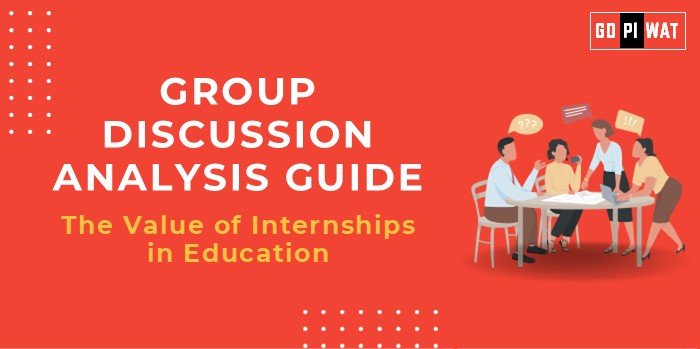📋 GD Analysis: The Value of Internships in Education
🌐 Introduction to the Value of Internships in Education
📖 Internships bridge the gap between classroom learning and real-world applications, providing students with essential skills and industry insights that pave the way for successful careers. They are increasingly recognized worldwide as critical to educational success and career readiness.
Internships have evolved from optional experiences to integral components of education across the world. This trend is reflected in national initiatives, such as India’s Prime Minister’s Internship Scheme (PMIS), which aims to create structured internship opportunities for the nation’s youth.
📊 Quick Facts and Key Statistics
- 📈 Employment Prospects: 66.4% of interns secure full-time jobs post-internship, with an average starting salary increase of $15,000 compared to non-intern peers.
- 📜 New PM Internship Program: The PMIS aims to offer 1.25 lakh internships in 2024-25, scaling to one crore internships in the next five years.
- 🌍 Internship Participation: Over 60% of students worldwide engage in internships, demonstrating their universal recognition in education.
- 💰 Stipend and Financial Support: PMIS interns in India will receive ₹5,000 monthly and a one-time grant of ₹6,000, ensuring financial support during the program.
🤝 Stakeholders and Their Roles
- 🏫 Educational Institutions: Partner with industries to facilitate internships and guide students in applying theoretical knowledge practically.
- 🎓 Students: Gain hands-on experience, network, and enhance employability through internships.
- 💼 Employers: Assess potential hires, gain fresh perspectives, and contribute to workforce development through internships.
- 🏛️ Government & Policymakers: Support structured internship programs to close skill gaps, exemplified by PMIS.
🎯 Achievements and Challenges
🌟 Achievements:
- 📈 Enhanced Employability: Internships increase graduate employability by up to 66.4%, as shown by high job conversion rates.
- 🛠️ Skill Application and Development: Internships enable students to apply academic knowledge in real-world settings, enhancing practical skills.
- 💰 Financial Support: PMIS provides stipends and grants, reducing financial barriers to participation.
⚠️ Challenges:
- 📉 Access and Equity: Not all students have access to quality or paid internships, disproportionately affecting low-income students.
- ⚖️ Quality Variation: Some internships lack structure or adequate mentorship, limiting their educational value.
🌍 Global Comparisons
- 🇩🇪 Germany: Structured apprenticeships are integrated into education, setting benchmarks for internship programs.
📖 Case Study:
India’s PMIS is an ambitious initiative aiming to provide one crore internships, addressing employability among youth by partnering with top 500 companies across industries.
📄 Structured Arguments for Discussion
🔹 Supporting Stance: “Internships provide essential experience, significantly improving employability and career-readiness, and the PMIS makes internships accessible to thousands of Indian youth.”
🔹 Opposing Stance: “Not all internships provide valuable experiences, and unpaid internships can place financial burdens on students, particularly those from lower-income backgrounds.”
🔹 Balanced Perspective: “While internships offer substantial benefits in terms of job skills and employability, increasing the quality and accessibility of internships will ensure they provide true educational value for all students.”
📊 Effective Discussion Approaches
- 📈 Statistical Impact: “Statistics show 66.4% of interns secure full-time jobs post-internship, with a $15,000 salary advantage, highlighting the career impact of internships.”
- 📜 Program Reference: “The PMIS aims to provide 1.25 lakh internships this fiscal year, marking a strong government initiative to address youth employability.”
- ⚖️ Counter-Argument Handling: Address equity concerns by recommending measures like PMIS stipends and suggesting public-private partnerships for expanding internship access.
💡 Strategic Analysis of Strengths and Weaknesses
Strengths:
- 🛠️ Real-world experience.
- 📈 Increased employability.
- 💰 Financial support (in PMIS).
Weaknesses:
- 📉 Unequal access to quality internships.
- ⚖️ Inconsistency in mentorship and structure.
Opportunities:
- 🌐 Expansion of remote internship opportunities.
- 🤝 Partnerships for quality assurance and standardization.
Threats:
- 📉 Dependence on unpaid internships.
- ⚖️ Inequities in accessibility and program distribution.
📚 Connecting with B-School Applications
- 💼 Real-World Applications: Internship experience applies to B-school projects in operations, HR, and project management.
- 🎓 Sample Interview Questions:
- “How did your internship experience prepare you for this program?”
- “What transferable skills did you gain through internships?”
- 💡 Insights: Internships build key management skills and deepen industry understanding, critical for business success.


